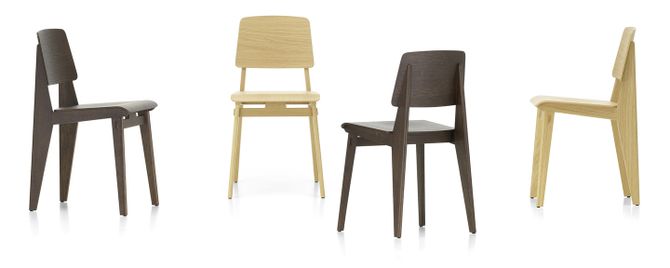
Chaise Tout Bois
Jean Prouvé, 1941
Prouvé created several prototypes of this chair during the war for the purpose of testing its structural strength as well as the joints, leg position and connection between the seat and back. The chosen type of wood depended on what was available at the time. After the war, there was once again a sufficient supply of oak, which due to its hardness and strength was commonly used in France to construct ships and cathedral roofs. As these properties are also ideal for an all-wood chair, the Chaise Tout Bois was ultimately made out of oak and plywood – also offered in dark-stained versions when requested by Jean Prouvé's customers.
In 1947, Prouvé won an award for the Chaise Tout Bois in the 'Meubles de France' competition. The concept of the competition was to find attractive, high-quality, mass-produced furnishings to meet the post-war needs of society – particularly refugees and young married couples. Later the Chaise Tout Bois was replaced by a knock-down version in metal and wood, which was then supplanted by Model No. 305, likewise combining a metal base with a wooden seat and backrest – known today as the Standard chair.
Chaise Tout Bois by Vitra corresponds to one of Jean Prouvé's design variants from 1941, whose construction does not require a single screw. The height and seat geometry are the same as those of the Standard chair and thus meet current norms and requirements. The warm look and feel of wood contrasts appealingly with the practical structural design, which is typical of Prouvé's functional approach. Chaise Tout Bois is available in light oak or dark-stained oak.
Information
- Seat and backrest: moulded plywood veneer in natural or dark-stained oak, protective natural lacquer finish.
- Base: non-stackable solid wood base; same type of wood as backrest and seat in natural or dark-stained oak, protective natural lacquer finish.
- Origin of wood: solid oak (Quercus robur) from Croatia, veneer wood from the USA.
Standard
Chairs take the most stress on their back legs, where they bear the weight of the user's upper body. The engineer and designer Jean Prouvé illustrated this simple insight in his distinctive design for the Standard chair: while steel tubing suffices for the front legs, since they bear a relatively light load, the back legs are made of voluminous hollow sections that transfer the primary stress to the floor. Standard is offered with a seat and backrest in wood or as the model Standard SP in ASA plastic. In addition, there is the all-wood Chaise Tout Bois, whose design is very similar to the Standard chair. During World War II, Jean Prouvé responded to the limited supply of metal with a version made entirely out of veneer and solid wood.
Jean Prouvé
Jean Prouvé, who regarded himself as an engineer throughout his lifetime, was both the designer and manufacturer of his product ideas. His unique oeuvre, ranging from a letter opener to door and window fittings, from lighting and furniture to prefabricated houses and modular building systems, encompasses almost anything that is suited to industrial production and construction.